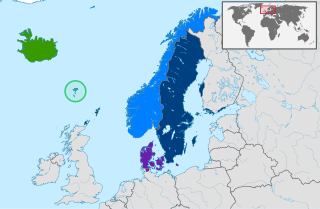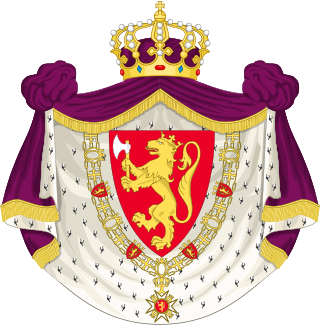Related Research Articles

Norwegian is a North Germanic language from the Indo-European language family spoken mainly in Norway, where it is an official language. Along with Swedish and Danish, Norwegian forms a dialect continuum of more or less mutually intelligible local and regional varieties; some Norwegian and Swedish dialects, in particular, are very close. These Scandinavian languages, together with Faroese and Icelandic as well as some extinct languages, constitute the North Germanic languages. Faroese and Icelandic are not mutually intelligible with Norwegian in their spoken form because continental Scandinavian has diverged from them. While the two Germanic languages with the greatest numbers of speakers, English and German, have close similarities with Norwegian, neither is mutually intelligible with it. Norwegian is a descendant of Old Norse, the common language of the Germanic peoples living in Scandinavia during the Viking Age.

The Constitution of Norway was adopted on 16 May and signed on 17 May 1814 by the Norwegian Constituent Assembly at Eidsvoll. The latter date is the National Day of Norway; it marks the establishment of the constitution.

The North Germanic languages make up one of the three branches of the Germanic languages—a sub-family of the Indo-European languages—along with the West Germanic languages and the extinct East Germanic languages. The language group is also referred to as the Nordic languages, a direct translation of the most common term used among Danish, Faroese, Icelandic, Norwegian, and Swedish scholars and people.
Bokmål is one of the official written standards for the Norwegian language, alongside Nynorsk. Bokmål is by far the most used written form of Norwegian today, as it is adopted by 85% to 90% of the population in Norway. There is no countrywide standard or agreement on the pronunciation of Bokmål and the spoken dialects vary greatly.

"Ja, vi elsker dette landet" is the national anthem of Norway. Originally a patriotic song, it became commonly regarded as the de facto national anthem of Norway in the early 20th century after being used alongside "Sønner av Norge" since the 1860s. It was officially adopted in 2019.
Nynorsk is one of the two official written standards of the Norwegian language, the other being Bokmål. From 12 May 1885, it became the state-sanctioned version of Ivar Aasen's standard Norwegian language (Landsmål), parallel to the Dano-Norwegian written standard known as Riksmål. The name Nynorsk was introduced in 1929. After a series of reforms, it is still the written standard closer to Landsmål, whereas Bokmål is closer to Riksmål and Danish.

The national flag of Norway is red with a navy blue Scandinavian cross bordered in white that extends to the edges of the flag; the vertical part of the cross is shifted to the hoist side in the style of the Dannebrog, the flag of Denmark.

Sweden and Norway or Sweden–Norway, officially the United Kingdoms of Sweden and Norway, and known as the United Kingdoms, was a personal union of the separate kingdoms of Sweden and Norway under a common monarch and common foreign policy that lasted from 1814 until its peaceful dissolution in 1905.
Riksmål is an unofficial written Norwegian language form or spelling standard, meaning the National Language, closely related and now almost identical to the dominant form of Bokmål, known as Moderat Bokmål.
The Norwegian Academy for Language and Literature, commonly known as the Norwegian Academy, is a Norwegian learned body on matters pertaining to the modern Norwegian language in its Dano-Norwegian variety, now commonly known as Riksmål and Bokmål. The academy was established in the Norwegian government's honorary residence Grotten in 1953 based on the model of the Swedish Academy and the French Academy, but the idea was originally conceived by Bjørn Bjørnson in 1913. Its members are elected for life on the basis of scholarly, literary or artistic merits. The academy publishes the main dictionary of Norwegian, Det Norske Akademis ordbok, is responsible for regulating the written standard known as Riksmål and has a literary and cultural purpose. The academy awards the Norwegian Academy Prize in memory of Thorleif Dahl.

Norwegian dialects are commonly divided into four main groups, 'Northern Norwegian', 'Central Norwegian', 'Western Norwegian', and 'Eastern Norwegian'. Sometimes 'Midland Norwegian' and/or 'South Norwegian' are considered fifth or sixth groups.

Knud Knudsen was a Norwegian educator, author, linguist and philologist, known as "The Father of Bokmål". He is best known for having assembled from Dano-Norwegian one of the two official written versions of the Norwegian language, Bokmål, one of the two official written versions of the Norwegian language.

The coat of arms of Norway is the arms of dominion of King Harald V of Norway, and as such represents both the monarch and the kingdom. It depicts a standing golden lion on a red background, bearing a golden crown and axe with silver blade.
Dano-Norwegian was a koiné/mixed language that evolved among the urban elite in Norwegian cities during the later years of the union between the Kingdoms of Denmark and Norway (1536/1537–1814). It is from this koiné that the unofficial written standard Riksmål and the official written standard Bokmål developed. Bokmål is now the most widely used written standard of contemporary Norwegian.

The union mark of Norway and Sweden was a symbol of the Union between Sweden and Norway. It was inserted into the canton of the Swedish and Norwegian national flags from 1844 to denote the partnership of the two countries in a personal union. The mark combined the flag colours of both kingdoms, equally distributed, to reflect their equal status within the union. The stand-alone design of the mark was used for the diplomatic flag and the naval jack of the union. The union mark remained part of the flags of both countries until it was removed from the merchant and state flags of Norway in 1899 because of increasing Norwegian dissatisfaction with the union. It remained on the naval ensign of Norway and all Swedish flags until the dissolution of the union between Norway and Sweden in 1905.

The Norwegian language conflict is an ongoing controversy in Norwegian culture and politics about the different varieties of written Norwegian. From 1536/1537 until 1814, Danish was the standard written language of Norway due to the union of crowns with Denmark. As a result, the proximity of modern written Norwegian to Danish underpins controversies in anti-imperialistic nationalism, rural versus urban cultures, literary history, diglossia, spelling reform, and orthography.

Denmark and Norway have a very long history together: they were both part of the Kalmar Union between 1397 and 1523, and Norway was in a Union with Denmark between 1524 and 1814.

Denmark–Norway is a term for the 16th-to-19th-century multi-national and multi-lingual real union consisting of the Kingdom of Denmark, the Kingdom of Norway, the Duchy of Schleswig, and the Duchy of Holstein. The state also claimed sovereignty over three historical peoples: Frisians, Gutes and Wends. Denmark–Norway had several colonies, namely the Danish Gold Coast, Danish India, and the Danish West Indies. The union was also known as the Dano-Norwegian Realm, Twin Realms (Tvillingerigerne) or the Oldenburg Monarchy (Oldenburg-monarkiet).
Profanity in the Norwegian language is referred to in Norwegian as banneord or simply upassende språk. Many words are characterized by dialect. The offensiveness and strength of a word may be very different between regions.
Republicanism in Norway is a movement to replace the constitutional monarchy with a republican form of government. The country has always been ruled by a monarch and has never been a republic. Since 1905 and the dissolution of the union with Sweden several republican movements and thoughts have arisen. Currently, the Norwegian Republican Association is the only non-partisan organisation campaigning to abolish the monarchy and make Norway a republic.
References
- ↑ "Næringsstruktur i Norge" - from the website of the Norwegian government
- ↑ "Sveriges förbindelser med Norge" - from the website of the Swedish government
- ↑ Persvold, Anja Zawadzka (2021-11-08), "svesisme", Store norske leksikon (in Norwegian Bokmål), retrieved 2022-06-21
- ↑ "Ord i grenseland". Norwegian Language Council (in Norwegian Bokmål). Retrieved 2022-06-21.
- ↑ «Der lå vi et folk bag, et andet berømmeligt rige» Om svesismer i unionstiden 1814–1905 Archived 2011-06-05 at the Wayback Machine by Finn-Erik Vinje of the Norwegian Language Council. Page visited December 19, 2007